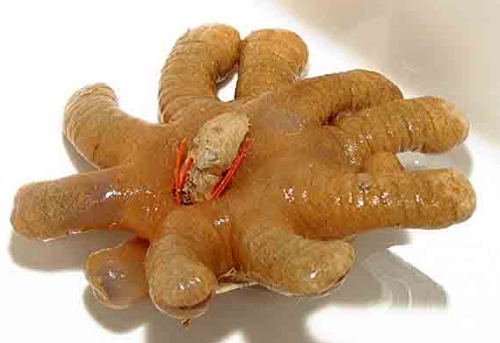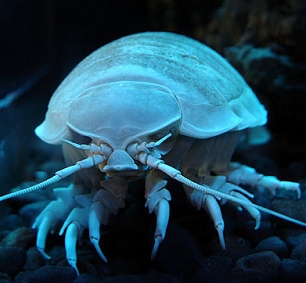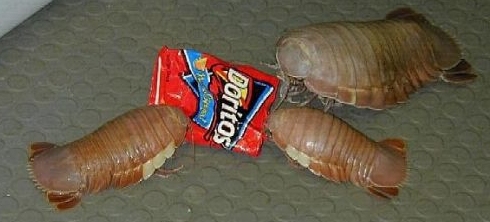| The Abyss - Part IV - Abyssal Arthropoda |
| Written by Jonathan C. Wojcik - Photo credits unknown or from public news articles unless otherwise noted. If you know their sources and need them credited or removed, please e-mail me. |
| Anemone Hermits |
If you've read my "Killer Crustaceans" article, you're already familiar with the "bugs" of the ocean
and at least one of their abyssal representatives, the sinister Phronima. Rest assured, there's far
more to the deep sea's exoskeletal freak-show...
and at least one of their abyssal representatives, the sinister Phronima. Rest assured, there's far
more to the deep sea's exoskeletal freak-show...

Rather than borrowing the shell of a sea snail - a rarity in the Abyssopelagic - the Sympagurus
hermit crab protects its fragile abdomen with the tough, leathery body of a stinging Zonathid. This
coral-like animal would otherwise find nothing to grow upon in the miles of soft mud that
predominate abyssal terrain, but finds both a sturdy foundation and convenient transport on the
back of the small crustacean.
hermit crab protects its fragile abdomen with the tough, leathery body of a stinging Zonathid. This
coral-like animal would otherwise find nothing to grow upon in the miles of soft mud that
predominate abyssal terrain, but finds both a sturdy foundation and convenient transport on the
back of the small crustacean.
| Sea Spiders |

Though they resemble arachnids at first glance, the Pycnogonidae or "sea spiders" belong to their
own group distinct from the arachnids, crustaceans or any other arthropod. They are found
throughout oceanic environments, but grow to their most impressive sizes in the abyss, where they
live vampirically off the fluids of larger anemones, sea cucumbers, hydrozoans and other
soft-bodied animals. Only males are known to care for the eggs and young, which begin life as
literally nothing more than swimming heads, acquiring bodies and legs at later stages of
development. Because their bodies are so tiny, the legs contain many of their internal organs,
including most of the digestive tract.
own group distinct from the arachnids, crustaceans or any other arthropod. They are found
throughout oceanic environments, but grow to their most impressive sizes in the abyss, where they
live vampirically off the fluids of larger anemones, sea cucumbers, hydrozoans and other
soft-bodied animals. Only males are known to care for the eggs and young, which begin life as
literally nothing more than swimming heads, acquiring bodies and legs at later stages of
development. Because their bodies are so tiny, the legs contain many of their internal organs,
including most of the digestive tract.

| Giant Isopods |


The Isopoda are actually one of our planet's most common crustaceans, even found on dry land
where we refer to them as woodlice, sowbugs, roly-polies or pillbugs, and in some countries,
butcher-boys, chuggypegs, cheesylogs or granfer gravies. Yes, really. Like the sea spiders, the
largest of all isopods are those living closest to the pits of Hades. Reaching over a foot in length,
the ghostly and beautiful Bathynomus giganteus are dominant scavengers of the sea floor, known
to swarm over carcasses and gorge themselves on meat until almost too bloated to walk.
Like many other granfer gravies, female giganteus develop a pouch called a marsupium to carry
their eggs, though little else is known of their reproductive habits.
where we refer to them as woodlice, sowbugs, roly-polies or pillbugs, and in some countries,
butcher-boys, chuggypegs, cheesylogs or granfer gravies. Yes, really. Like the sea spiders, the
largest of all isopods are those living closest to the pits of Hades. Reaching over a foot in length,
the ghostly and beautiful Bathynomus giganteus are dominant scavengers of the sea floor, known
to swarm over carcasses and gorge themselves on meat until almost too bloated to walk.
Like many other granfer gravies, female giganteus develop a pouch called a marsupium to carry
their eggs, though little else is known of their reproductive habits.

| Giant Seed-Shrimp |


So named for their hinged, clam-like outer shell, the Ostracoda or "seed shrimp" are found in
nearly all the world's aquatic environments, even appearing suddenly in puddles of rain water.
Usually no larger than the head of a pin, I shouldn't have to explain at this point where you can find
their most impressive representative; Gigantocypris agassizii, a gumdrop-sized leviathan with
huge, reflective eyes. As if I didn't like it enough already, one publication has dubbed it "the
Halloween Jack-O-Lantern of the deep."
nearly all the world's aquatic environments, even appearing suddenly in puddles of rain water.
Usually no larger than the head of a pin, I shouldn't have to explain at this point where you can find
their most impressive representative; Gigantocypris agassizii, a gumdrop-sized leviathan with
huge, reflective eyes. As if I didn't like it enough already, one publication has dubbed it "the
Halloween Jack-O-Lantern of the deep."